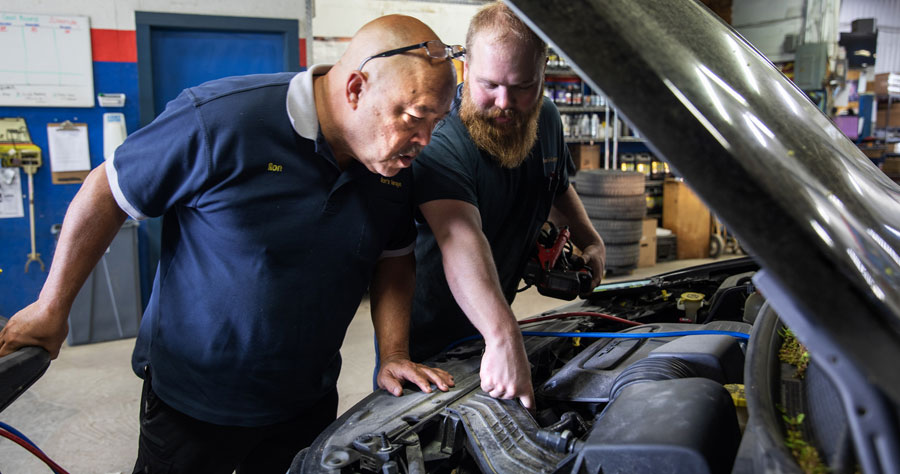
Engine Repair in Ann Arbor
Your vehicle’s engine is the heart of its performance, and when something goes wrong it affects every part of your drive. Engines convert gasoline or diesel into energy through internal combustion—a process where fuel and air mix, ignite, and release power in a rapid cycle of strokes.
While the basic concept is the same, engines come in different configurations. The number and arrangement of cylinders determine the engine’s name, efficiency, performance, and overall durability. At Ron’s Garage, we service a variety of common engine types, from everyday four-cylinder to powerful V8s, ensuring your vehicle stays reliable on Ann Arbor’s busy streets and Michigan highways.

Engine Types
Four-Stroke Engine Repair
The 4-stroke engine is the foundation for most vehicles we see in our shop. It cycles through four distinct stages:
-
-
- Intake Stroke: Fuel and air moves into the holding chamber (cylindrical tube) from the intake valve.
- Compression Stroke: The piston compresses the mixture against the spark plug.
- Power Stroke: A spark ignites the mixture, producing an explosion that drives the piston downward.
- Exhaust Stroke: The exhaust valve opens, expelling exhaust gases, and then the 4-stroke cycle begins again.
-
This cycle repeats hundreds of times per minute. Regular maintenance ensures it performs smoothly, whether you’re navigating football game traffic near the Big House or commuting along I-94.
Inline Four Engine Repair
The inline four-cylinder engine is the most common engine in small to midsize cars. It’s compact, fuel-efficient, and dependable—ideal for Ann Arbor drivers who need a balance of reliability and space. It provides steady performance for everyday commuting, from campus runs to cross-town errands.
V6 Engine Repair
A V6 engine, with its six cylinders arranged in a “V” shape, provides more power and smoother operation compared to the inline four. This design reduces vibration and offers stronger acceleration while still fitting into most modern engine compartments. It’s a popular choice for Ann Arbor residents who want greater performance for those longer drives up north or frequent trips down the US-23.
V8 Engine Repair
The V8 is one of the most powerful and iconic engine configurations, often found in trucks, SUVs, and performance cars. With eight cylinders in a “V” shape, it delivers excellent horsepower, strong torque, and durability under demanding conditions. Although the V-8 consumes more fuel than smaller engines, it out performs them in towing, hauling, and high-performance driving. The V-8 is ideal for Michigan winters, road trips, or handling heavy loads across Washtenaw County.
Engine Displacement Measurement (liters)
Engine displacement describes the size of an engine in liters. It measures the maximum amount of air the engine cylinders can displace (move) through one engine cycle, like the 4-stroke process described above. The engine displacement calculation includes the cylinder diameter (bore), the distance the piston travels (stroke), and the number of cylinders in the engine. The higher the displacement value, the bigger, more powerful the engine and the more space it requires.
Why Engine Maintenance Matters in Michigan
Michigan driving puts engines to the test. Cold winter starts, road salt, hot summer highway trips, and stop-and-go traffic in Ann Arbor all add stress to your vehicle. Without proper care, minor engine problems can quickly turn into major repairs.
Routine Maintenance
Timely oil changes, inspections, and fluid checks—not only improves performance but also helps prevent breakdowns when you need your vehicle the most. Whether you’re driving across town, heading north for a weekend trip, or navigating U-M game day traffic, keeping your engine in peak condition provides peace of mind.
Engine Parts
Cylinders
Cylinders contain the moving pistons mentioned above, and almost all modern engines have at least two. The arrangement of these cylinders contributes to different advantages and disadvantages, costs, and performance. Some arrangements are better suited for specific vehicles than others.
Spark plugs
As seen in the 4-stroke process, the spark plug ignites the air and fuel mixture, creating combustion, which harnesses the fuel mixture as mechanical energy. This process happens hundreds of times per minute to keep the engine running.
Valves
The intake valve opens when pushing air and fuel into the chamber. The exhaust valve opens when expelling exhaust gases after combustion. During the compression and combustion strokes, both values are closed, sealing the chamber to ensure proper pressure.
Pistons
Pistons are metal components that move within the cylinder. Piston rings create a seal to prevent fuel, air, and exhaust from entering the oil sump. As these rings wear out, the seal weakens and the engine may begin to burn more oil.
Connecting Rod
The connecting rod links the piston to the crankshaft, transferring motion between the two.
Crankshaft
The crankshaft acts like the arm of a jack-in-the-box—its rotation drives the piston in a circular motion throughout the combustion process.
Oil Sump
The oil sump holds engine oil at the bottom of the engine. This oil lubricates moving parts and prevents metal-on-metal contact between the crankshaft and the engine block.
Engine Repair & Replacement
When an engine needs repairs or fails, the root cause is often attributed to one of three main issues: A bad fuel mix, lack of compression, or lack of spark.
Bad Fuel Mix
This occurs when the engine receives too much or too little air or fuel, resulting in incomplete combustion. Causes can include running out of fuel, clogged valves, fuel impurities, or problems within the fuel system.
Lack of Compression
If there is a lack of sufficient compression, the air and fuel mixture cannot ignite properly. This can happen when piston rings are not sealing, valves fail to close, or a hole develops in a cylinder. Another common issue is a damaged head gasket, which sits between the cylinder block (AKA engine block) and cylinder head. This gasket not only seals the fuel and air in the cylinders, but also seals the oil and coolant passages, keeping them from leaking or mixing together.
Lack of Spark
A spark issue is usually electrical. If the spark plug, its wiring, or the ignition system is faulty, the spark may be weak, delayed, or absent altogether, preventing proper combustion.


